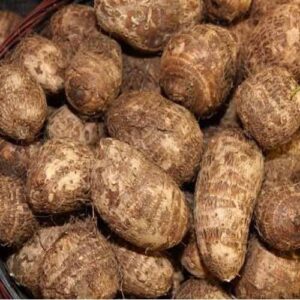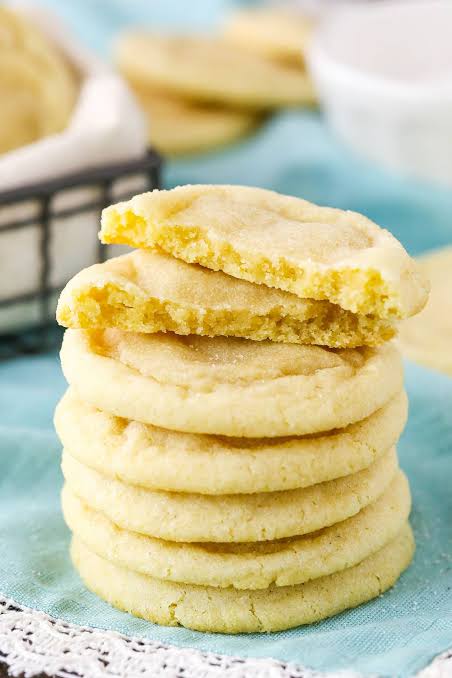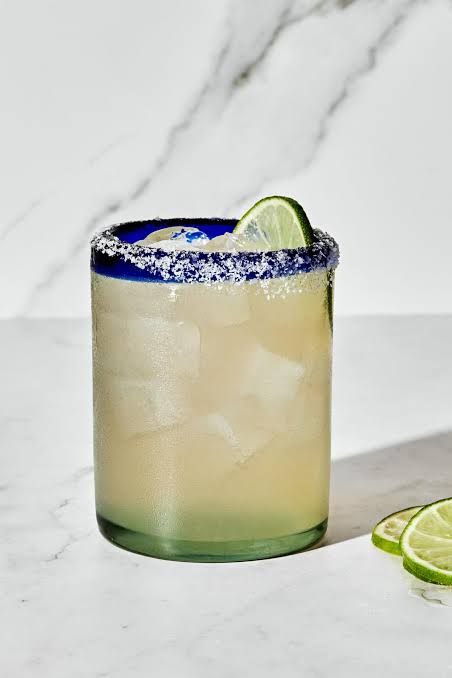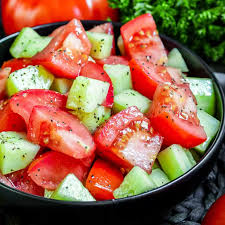
How Long Can a Salad with Just Tomatoes and Cucumbers Last in the Freezer?”
- Introduction
- Overview of freezing foods as a preservation method.
- Common salads featuring tomatoes and cucumbers.
- The challenges of freezing fresh vegetables like tomatoes and cucumbers.
- The goal of the article: to explore the feasibility and limitations of freezing a tomato and cucumber salad.
- Understanding the Ingredients: Tomatoes and Cucumbers
- Nutritional content and health benefits of tomatoes and cucumbers.
- The physical and chemical properties of tomatoes and cucumbers that affect freezing.
- How freezing impacts the texture and flavor of tomatoes and cucumbers.
- The Science of Freezing Fresh Vegetables
- How freezing preserves food by slowing down enzymatic reactions and microbial growth.
- The effects of freezing on water-rich vegetables like tomatoes and cucumbers.
- The concept of freezer burn and its impact on frozen vegetables.
- Challenges of Freezing a Tomato and Cucumber Salad
- High water content in tomatoes and cucumbers leading to texture degradation.
- The formation of ice crystals and their effect on cell structure.
- The potential loss of flavor and nutritional value.
- How freezing can affect the appearance of the salad.
- Step-by-Step Guide to Freezing a Tomato and Cucumber Salad
- Preparation Before Freezing
- Selecting the freshest tomatoes and cucumbers.
- Washing, peeling (optional), and slicing vegetables.
- Optional: Blanching tomatoes and cucumbers to reduce enzyme activity.
- Freezing Techniques
- Individually freezing tomato and cucumber slices before combining them.
- Using airtight containers or vacuum-sealing bags to prevent freezer burn.
- Labeling and dating the salad before freezing.
- Storage Conditions
- Ideal temperature settings for the freezer.
- Proper arrangement in the freezer to avoid crushing the salad.
- Preparation Before Freezing
- Expected Shelf Life of Frozen Tomato and Cucumber Salad
- General guidelines on the shelf life of frozen vegetables.
- Factors that influence the longevity of frozen tomato and cucumber salad.
- How to determine if the salad is still good to eat after freezing.
- Thawing and Using Frozen Tomato and Cucumber Salad
- The best methods for thawing the salad to preserve texture and flavor.
- How freezing and thawing affect the salad’s consistency.
- Creative ways to use thawed tomato and cucumber salad (e.g., in soups, smoothies, or cooked dishes).
- Alternatives to Freezing
- Refrigeration: The shelf life of a tomato and cucumber salad in the refrigerator.
- Pickling: Preserving tomatoes and cucumbers with vinegar or brine.
- Dehydration: Making dried tomato and cucumber chips.
- Canning: Creating preserved tomato and cucumber relishes or salsas.
- Common Mistakes and Troubleshooting
- Identifying and avoiding common mistakes when freezing tomato and cucumber salad.
- Troubleshooting issues like soggy texture, off-flavors, and freezer burn.
- Health Considerations
- Nutritional changes in tomatoes and cucumbers due to freezing.
- Comparing the health benefits of fresh versus frozen salads.
- Addressing concerns about potential nutrient loss during freezing.
- Conclusion
- Recap of the key points on freezing a tomato and cucumber salad.
- Recommendations for successfully freezing and using the salad.
- Final thoughts on whether freezing is a practical solution for this type of salad
Read this also:- Alfredo sauce recipe , Buttermilk recipe
1. Introduction
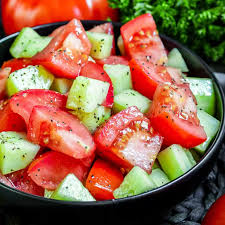
Freezing is one of the most widely used methods for preserving food, particularly for extending the shelf life of fruits and vegetables. However, not all foods are well-suited for freezing, especially those with high water content like tomatoes and cucumbers. These ingredients are popular in fresh salads, but when it comes to freezing, they present unique challenges.
In this article, we will explore whether it’s possible to freeze a salad made solely of tomatoes and cucumbers, how long it can last in the freezer, and what you can expect in terms of texture, flavor, and nutritional value after thawing. By understanding the science behind freezing these vegetables, you’ll be better equipped to make informed decisions about preserving your tomato and cucumber salad for future use.
2. Understanding the Ingredients: Tomatoes and Cucumbers
Tomatoes and cucumbers are beloved for their refreshing taste, vibrant color, and nutritional benefits. Tomatoes are rich in vitamins A and C, potassium, and lycopene, an antioxidant linked to numerous health benefits. Cucumbers, while lower in calories, provide hydration, vitamin K, and various antioxidants.
However, both tomatoes and cucumbers have a high water content—about 95% and 96% respectively. This high moisture level contributes to their crisp texture when fresh but also makes them more prone to texture changes when frozen. Freezing can cause water within the cells of these vegetables to expand and form ice crystals, which can rupture cell walls and lead to a mushy texture once thawed.
Understanding these physical and chemical properties is essential when considering freezing as a method of preservation. While freezing can effectively halt bacterial growth and slow down spoilage, it also has significant effects on the texture, flavor, and nutritional quality of the ingredients.
3. The Science of Freezing Fresh Vegetables
Freezing works by lowering the temperature of food to levels where microbial growth is significantly slowed or halted. In vegetables, freezing also slows down enzymatic reactions that cause spoilage and nutrient degradation. However, the freezing process can have adverse effects, particularly on vegetables with high water content.
When tomatoes and cucumbers are frozen, the water inside their cells expands as it turns into ice. These ice crystals can puncture cell walls, leading to a loss of firmness and crispness. Upon thawing, the vegetables may become watery and soft, a far cry from their fresh state. Additionally, the process of freezing can concentrate flavors, which might lead to a slight change in taste.
Freezer burn is another concern when freezing vegetables. This occurs when food is not properly sealed, leading to moisture loss and oxidation. Freezer burn can cause discoloration, off-flavors, and a tough, dry texture.
4. Challenges of Freezing a Tomato and Cucumber Salad
Freezing a salad composed solely of tomatoes and cucumbers poses several challenges:
- Texture Degradation: As mentioned, the high water content in both vegetables leads to significant texture changes when frozen. Tomatoes, which are especially delicate, can become mushy and lose their structural integrity. Cucumbers, while slightly more resilient, can also turn limp and watery after thawing.
- Flavor Changes: The freezing process can alter the flavor of both tomatoes and cucumbers. The taste may become more subdued, and any subtle sweetness or tanginess might diminish. Additionally, any dressing or seasoning added to the salad before freezing can also be affected.
- Appearance: The visual appeal of a fresh tomato and cucumber salad is often a key part of its enjoyment. Unfortunately, freezing can lead to color changes, with tomatoes potentially losing their bright red hue and cucumbers becoming more translucent or dull.
Given these challenges, it’s important to weigh the pros and cons of freezing such a salad, particularly if you are looking to preserve it for later consumption.
5. Step-by-Step Guide to Freezing a Tomato and Cucumber Salad
Preparation Before Freezing
Selecting Fresh Produce: Start by choosing the freshest tomatoes and cucumbers available. The quality of the vegetables at the time of freezing will directly impact their condition after thawing. Opt for firm, unblemished tomatoes and cucumbers with a vibrant color.
Washing and Slicing: Thoroughly wash the tomatoes and cucumbers under cold water. If desired, peel the cucumbers, though this is not necessary. Slice the tomatoes and cucumbers evenly to ensure consistent freezing.
Blanching (Optional): Blanching involves briefly boiling the vegetables before freezing them to deactivate enzymes that can cause spoilage and texture degradation. For tomatoes and cucumbers, blanching is optional but can help preserve color and texture. If blanching, immerse the slices in boiling water for 30 seconds to a minute, then quickly transfer them to an ice bath to halt the cooking process.
Freezing Techniques
Individually Freezing Slices: Lay the sliced tomatoes and cucumbers in a single layer on a baking sheet lined with parchment paper. Place the sheet in the freezer until the slices are solid. This method prevents the slices from sticking together.
Packaging for Freezing: Once the slices are frozen, transfer them to an airtight container or vacuum-seal them in bags. This will help prevent freezer burn and maintain quality. Be sure to label the container with the date.
Storage Conditions: Store the packaged salad in the coldest part of the freezer, ideally at 0°F (-18°C) or lower. Properly stored, the salad can last up to 2 months, but for optimal quality, it’s recommended to use it within 1 month.
6. Expected Shelf Life of Frozen Tomato and Cucumber Salad
Generally, frozen vegetables can last anywhere from 8 to 12 months in the freezer if stored properly. However, due to the delicate nature of tomatoes and cucumbers, the shelf life of a frozen tomato and cucumber salad is significantly shorter. For best quality, it’s advisable to consume the salad within 1 month of freezing.

